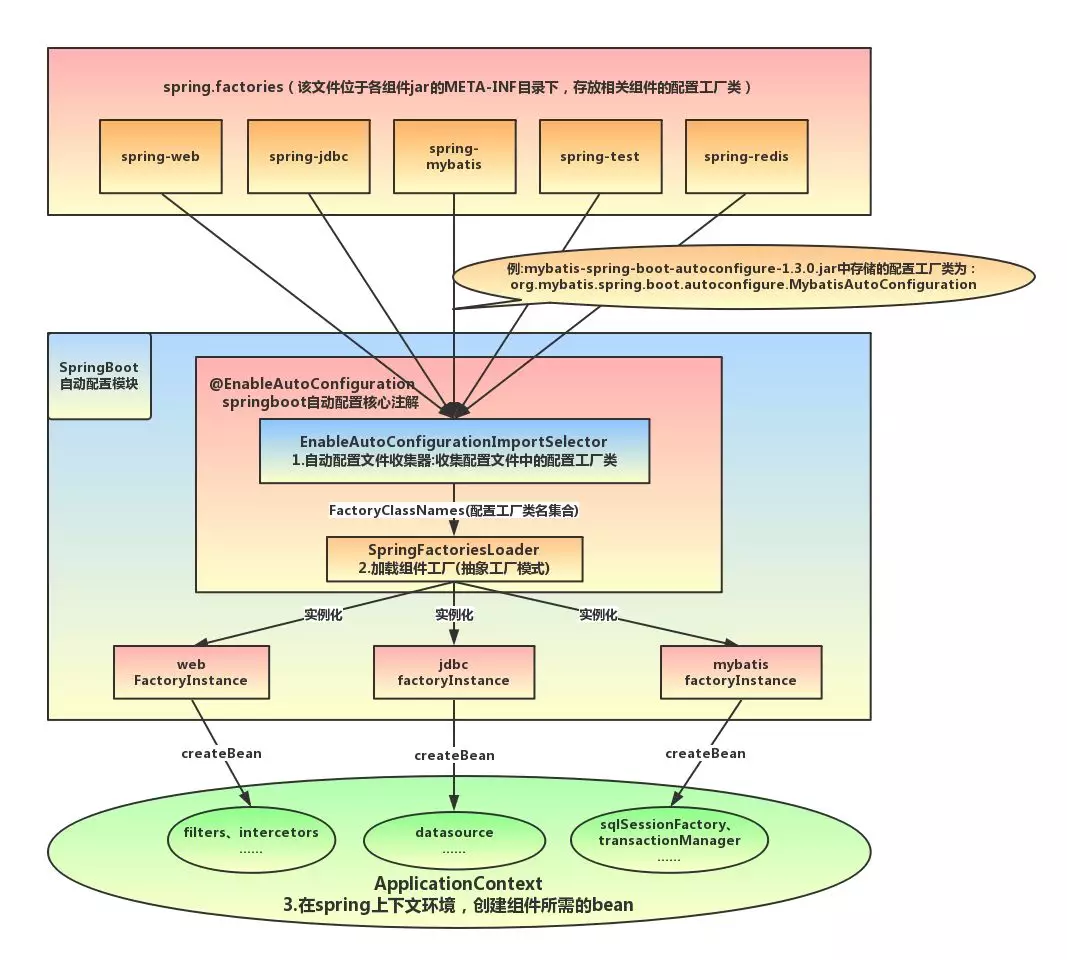本文主要记录了学习SpringBoot启动原理及其相关注解知识
@SpringBootApplication
@SpringBootApplication注解是Spring Boot的核心注解,它其实是一个组合注解:1
2
3
4
5
6
7
8
9
10
11
12
13
14
15
16
17({ElementType.TYPE})
(RetentionPolicy.RUNTIME)
(
excludeFilters = {(
type = FilterType.CUSTOM,
classes = {TypeExcludeFilter.class}
), (
type = FilterType.CUSTOM,
classes = {AutoConfigurationExcludeFilter.class}
)}
)
public SpringBootApplication {
}
虽然定义使用了多个Annotation进行了原信息标注,但实际上重要的只有三个Annotation:
- @Configuration(@SpringBootConfiguration点开查看发现里面还是应用了@Configuration)
- @EnableAutoConfiguration
- @ComponentScan
即 @SpringBootApplication = (默认属性)@Configuration + @EnableAutoConfiguration + @ComponentScan。
@Configuration
@Configuration比较熟悉,就不详细赘述了,简单的记录一下。
它就是JavaConfig形式的Spring Ioc容器的配置类使用的那个@Configuration,SpringBoot社区推荐使用基于JavaConfig的配置形式,所以,这里的启动类标注了@Configuration之后,本身其实也是一个IoC容器的配置类。
@ComponentScan
@ComponentScan这个注解在Spring中很重要,它对应XML配置中的元素,@ComponentScan的功能其实就是自动扫描并加载符合条件的组件(比如@Component和@Repository等)或者bean定义,最终将这些bean定义加载到IoC容器中。
我们可以通过basePackages等属性来细粒度的定制@ComponentScan自动扫描的范围,如果不指定,则默认Spring框架实现会从声明@ComponentScan所在类的package进行扫描。
注:所以SpringBoot的启动类最好是放在root package下,因为默认不指定basePackages。
@EnableAutoConfiguration
@EnableAutoConfiguration这个注解比较重要,所以着重了解下该注解。
Spring框架中有很多@Enable开头的自定义注解。比如@EnableScheduling、@EnableCaching、@EnableMBeanExport
- @EnableScheduling是通过@Import将Spring调度框架相关的bean定义都加载到IoC容器。
- @EnableMBeanExport是通过@Import将JMX相关的bean定义加载到IoC容器。
@EnableAutoConfiguration其实原理也是类似的,借助@Import的支持,收集和注册特定场景相关的bean定义。借助@Import的帮助,将所有符合自动配置条件的bean定义加载到IoC容器。
@EnableAutoConfiguration会根据类路径中的jar依赖为项目进行自动配置,如:添加了spring-boot-starter-web依赖,会自动添加Tomcat和Spring MVC的依赖,Spring Boot会对Tomcat和Spring MVC进行自动配置。
@EnableAutoConfiguration作为一个复合注解,其自身定义关键信息如下1
2
3
4
5
6
7
8
9
10
11
12
13({ElementType.TYPE})
(RetentionPolicy.RUNTIME)
({AutoConfigurationImportSelector.class})
public EnableAutoConfiguration {
String ENABLED_OVERRIDE_PROPERTY = "spring.boot.enableautoconfiguration";
Class<?>[] exclude() default {};
String[] excludeName() default {};
}
@Import(EnableAutoConfigurationImportSelector.class),借助EnableAutoConfigurationImportSelector,@EnableAutoConfiguration可以帮助SpringBoot应用将所有符合条件的@Configuration配置都加载到当前SpringBoot创建并使用的IoC容器。借助于Spring框架原有的一个工具类:SpringFactoriesLoader的支持,@EnableAutoConfiguration可以智能的自动配置
SpringFactoriesLoader
SpringFactoriesLoader属于Spring框架私有的一种扩展方案,主要功能就是从指定的配置文件META-INF/spring.factories加载配置。1
2
3
4
5
6
7
8
9
10
11
12
13
14
15
16
17
18
19
20
21
22
23
24
25
26
27
28
29
30/**
* General purpose factory loading mechanism for internal use within the framework.
*
* <p>{@code SpringFactoriesLoader} {@linkplain #loadFactories loads} and instantiates
* factories of a given type from {@value #FACTORIES_RESOURCE_LOCATION} files which
* may be present in multiple JAR files in the classpath. The {@code spring.factories}
* file must be in {@link Properties} format, where the key is the fully qualified
* name of the interface or abstract class, and the value is a comma-separated list of
* implementation class names. For example:
*
* <pre class="code">example.MyService=example.MyServiceImpl1,example.MyServiceImpl2</pre>
*
* where {@code example.MyService} is the name of the interface, and {@code MyServiceImpl1}
* and {@code MyServiceImpl2} are two implementations.
*
* @author Arjen Poutsma
* @author Juergen Hoeller
* @author Sam Brannen
* @since 3.2
*/
public final class SpringFactoriesLoader {
/**
* The location to look for factories.
* <p>Can be present in multiple JAR files.
*/
public static final String FACTORIES_RESOURCE_LOCATION = "META-INF/spring.factories";
...
}
配合@EnableAutoConfiguration使用的话,它更多是提供一种配置查找的功能支持,即根据@EnableAutoConfiguration的完整类名org.springframework.boot.autoconfigure.EnableAutoConfiguration作为查找的Key,获取对应的一组@Configuration类。
SPI机制
全称为Service Provider Interface,java.util.ServiceLoader的文档里有比较详细的介绍。
简单的总结下java SPI机制的思想。我们系统里抽象的各个模块,往往有很多不同的实现方案,比如日志模块的方案,xml解析模块、jdbc模块的方案等。面向的对象的设计里,我们一般推荐模块之间基于接口编程,模块之间不对实现类进行硬编码。一旦代码里涉及具体的实现类,就违反了可拔插的原则,如果需要替换一种实现,就需要修改代码。为了实现在模块装配的时候能不在程序里动态指明,这就需要一种服务发现机制。
java SPI就是提供这样的一个机制:为某个接口寻找服务实现的机制。有点类似IOC的思想,就是将装配的控制权移到程序之外,在模块化设计中这个机制尤其重要。
Spring Factories实现原理
- loadFactories 根据接口类获取其实现类的实例,这个方法返回的是对象列表。
- loadFactoryNames 根据接口获取其接口类的名称,这个方法返回的是类名的列表。
以上两个方法的关键都是从指定的ClassLoader中获取spring.factories文件,并解析得到类名列表。
1 | private static Map<String, List<String>> loadSpringFactories( ClassLoader classLoader) { |
从代码中我们可以知道,在这个方法中会遍历整个ClassLoader中所有jar包下的spring.factories文件。也就是说我们可以在自己的jar中配置spring.factories文件,不会影响到其它地方的配置,也不会被别人的配置覆盖。
spring.factories的是通过Properties解析得到的,所以我们在写文件中的内容都是安装下面这种方式配置的:
1 | com.xxx.interface=com.xxx.classname1,com.xxx.classname2 |
如果一个接口希望配置多个实现类,可以使用’,’进行分割。
下面是spring-boot包中的配置信息,其中”\”反斜杠是properties中的换行符。1
2
3
4
5
6
7
8
9
10
11
12
13
14
15
16
17
18
19
20
21
22
23
24
25
26
27
28
29
30
31
32
33
34
35
36
37
38
39
40
41
42
43
44
45
46
47
48
49
50
51
52
53
54
55
56
57# PropertySource Loaders
org.springframework.boot.env.PropertySourceLoader=\
org.springframework.boot.env.PropertiesPropertySourceLoader,\
org.springframework.boot.env.YamlPropertySourceLoader
# Run Listeners
org.springframework.boot.SpringApplicationRunListener=\
org.springframework.boot.context.event.EventPublishingRunListener
# Error Reporters
org.springframework.boot.SpringBootExceptionReporter=\
org.springframework.boot.diagnostics.FailureAnalyzers
# Application Context Initializers
org.springframework.context.ApplicationContextInitializer=\
org.springframework.boot.context.ConfigurationWarningsApplicationContextInitializer,\
org.springframework.boot.context.ContextIdApplicationContextInitializer,\
org.springframework.boot.context.config.DelegatingApplicationContextInitializer,\
org.springframework.boot.web.context.ServerPortInfoApplicationContextInitializer
# Application Listeners
org.springframework.context.ApplicationListener=\
org.springframework.boot.ClearCachesApplicationListener,\
org.springframework.boot.builder.ParentContextCloserApplicationListener,\
org.springframework.boot.context.FileEncodingApplicationListener,\
org.springframework.boot.context.config.AnsiOutputApplicationListener,\
org.springframework.boot.context.config.ConfigFileApplicationListener,\
org.springframework.boot.context.config.DelegatingApplicationListener,\
org.springframework.boot.context.logging.ClasspathLoggingApplicationListener,\
org.springframework.boot.context.logging.LoggingApplicationListener,\
org.springframework.boot.liquibase.LiquibaseServiceLocatorApplicationListener
# Environment Post Processors
org.springframework.boot.env.EnvironmentPostProcessor=\
org.springframework.boot.cloud.CloudFoundryVcapEnvironmentPostProcessor,\
org.springframework.boot.env.SpringApplicationJsonEnvironmentPostProcessor,\
org.springframework.boot.env.SystemEnvironmentPropertySourceEnvironmentPostProcessor
# Failure Analyzers
org.springframework.boot.diagnostics.FailureAnalyzer=\
org.springframework.boot.diagnostics.analyzer.BeanCurrentlyInCreationFailureAnalyzer,\
org.springframework.boot.diagnostics.analyzer.BeanDefinitionOverrideFailureAnalyzer,\
org.springframework.boot.diagnostics.analyzer.BeanNotOfRequiredTypeFailureAnalyzer,\
org.springframework.boot.diagnostics.analyzer.BindFailureAnalyzer,\
org.springframework.boot.diagnostics.analyzer.BindValidationFailureAnalyzer,\
org.springframework.boot.diagnostics.analyzer.UnboundConfigurationPropertyFailureAnalyzer,\
org.springframework.boot.diagnostics.analyzer.ConnectorStartFailureAnalyzer,\
org.springframework.boot.diagnostics.analyzer.NoSuchMethodFailureAnalyzer,\
org.springframework.boot.diagnostics.analyzer.NoUniqueBeanDefinitionFailureAnalyzer,\
org.springframework.boot.diagnostics.analyzer.PortInUseFailureAnalyzer,\
org.springframework.boot.diagnostics.analyzer.ValidationExceptionFailureAnalyzer,\
org.springframework.boot.diagnostics.analyzer.InvalidConfigurationPropertyNameFailureAnalyzer,\
org.springframework.boot.diagnostics.analyzer.InvalidConfigurationPropertyValueFailureAnalyzer
# FailureAnalysisReporters
org.springframework.boot.diagnostics.FailureAnalysisReporter=\
org.springframework.boot.diagnostics.LoggingFailureAnalysisReporter
总结
一张图概括下自动配置流程

参考资料
- https://www.jianshu.com/p/00e49c607fa1
- https://mp.weixin.qq.com/s?__biz=MzU2MTI4MjI0MQ==&mid=2247485906&idx=1&sn=100197909bbc525ec1cda59335e5cf39&chksm=fc7a647ccb0ded6ae2db78f8dc9a590bb3fdcd64e7bcb0a150ec0fea21f5d01aff44807784aa&mpshare=1&scene=24&srcid=0421OP1NJXUfRzKypZ06i3lq&key=5298608d5b36fb0ddde4e783d3a1813c216d1f173991315391772a045722c6a7aeb2f51a367c88148803ffb619d7d5f91748416250c55cd1bb90cc4ea2b6aa96ad379abd55e38913c2e694905d0704d0&ascene=14&uin=OTYxNTUxNDAw&devicetype=Windows+10&version=62080079&lang=zh_CN&exportkey=AQtLZxi%2BoUNOzXTlOKebY0o%3D&pass_ticket=orqmBNb9hzmVq87z7roh7JPuzSCJKc5zAEn1sgS%2F75PvnlU9ZH%2BlbuwbJmG9cAbu

